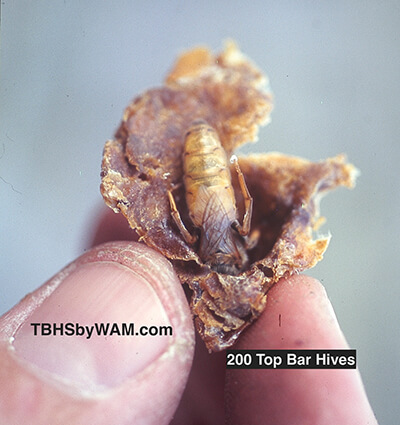
A newly made nuc–that swarms–is ruined. This problem, in my opinion, does not receive enough attention (see Figure 1).
In the spring, I spend considerable time with numerous swarms, nucs, bait hives, and queen cells. I see all kinds of situations. When nucs swarm, they become a problem. Typically, what remains is an excessively weak colony that cannot cover its combs. Later in the season, the colony is likely to be invaded by wax moths or small hive beetles, depending on its location. To save these weak nucs, they require resources from strong colonies: bees, brood, and honeycombs. To see why a small colony like a nuc would swarm, let’s review some swarm biology.
When a colony prepares to swarm, which is a splitting process, the bees build several queen cells to produce the daughter queens. One of these queens will inherit the parent colony, after the swarm departs with the mother queen. However, the reproductive biology of colonies can be more complicated than this one-swarm scenario.
The first swarm to leave the parent colony with the mother queen is called the prime swarm. If the colony is still crowded from subsequent brood emergence when the first virgin queens emerge, another swarm may launch. That first secondary swarm is called the after swarm. The first after swarm is typically smaller than the prime swarm and can contain one or more daughter queens, released from their queen cells. A second after swarm can depart, and rarely a third (at least for our bees in North America). The swarming can continue until the parent colony’s adult bee population becomes so depleted it cannot support further swarming.
From a bee management perspective, do not let colonies after swarm, even after losing the prime swarm. The resulting adult colony population may consist mostly of a scattering of drones and young worker bees. It will take weeks for the colony to recover.
To allocate the queens into the swarms, and leave one to inherit the parent colony, the bees regulate the queens’ emergence from their cells. That means even if a queen completes her development, the bees may not let her leave her cell. Delaying her emergence seems to be connected with an occasional worker bee standing on the queen cell and briefly shaking (vibrating) her abdomen. These vibrations apparently signal the queen inside the cell, who can be fully developed and even ready to fly, essentially to stop trying to emerge (see Figure 2).
Queens can be held in their cells for several days, waiting for the next after swarm to leave. And, of course, the confined queen becomes hungry. Beekeepers often ask me, how does a confined queen eat inside her cell? The answer is remarkably simple.
The queen cuts slits partway around the cap end of her cell, in the same way she would as she emerges. The bees reseal the slits and vibrate the cell to “subdue” her. Parts of these slits may remain unsealed as tiny cracks. Numerous times, I have seen a queen stick just her tongue through the tiny crack. With only her tongue (no antennae) which would be protruding into the dark void of the hive, the queen begs for food. Taking a picture of her tiny tongue was difficult, but see Figure 3. If I dip a little stem of grass in a honey cell and then touch it to the end of her tongue, the queen takes the honey like a hungry bee.
A colony that has swarmed usually has a noticeably reduced adult bee population. A missing mother queen is more evidence of recent swarming. There will probably be capped or sealed queen cells. (Both terms are beekeeper slang for queen cells with a queen in the pupal stage.) Look very carefully at the cap end of the cell for slits, even resealed slits in a different color of wax. I remove the queen cells from the comb and open them from the back and look for a live animated queen similar to Figure 2.
If I find any queens being held, from a bee management perspective, I figure the colony will after swarm. I remove all the queen cells. Some queen cells might have active queens in them; some may be empty. A queen cell might even have a dead worker bee in it (a cleaner bee went in the cell, the cap closed behind her, and the other bees resealed the slit, still intent on closing the cell). Make sure the parent colony has at least one free-roaming queen, but no queen cells. Miss a viable queen cell at this point and the bees will likely swarm. The bees will not swarm with only two or more free-roaming queens. Therefore, you do not need to hunt through the hive for multiple virgin queens, a tedious job.
Interestingly, once the bees are off a queen cell where they were inhibiting queen emergence, expect the queen to emerge within about ….


